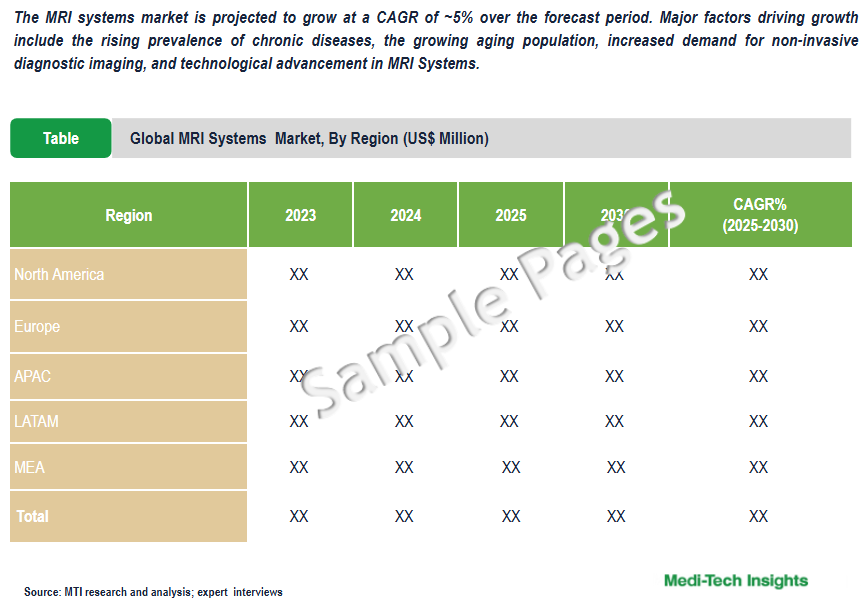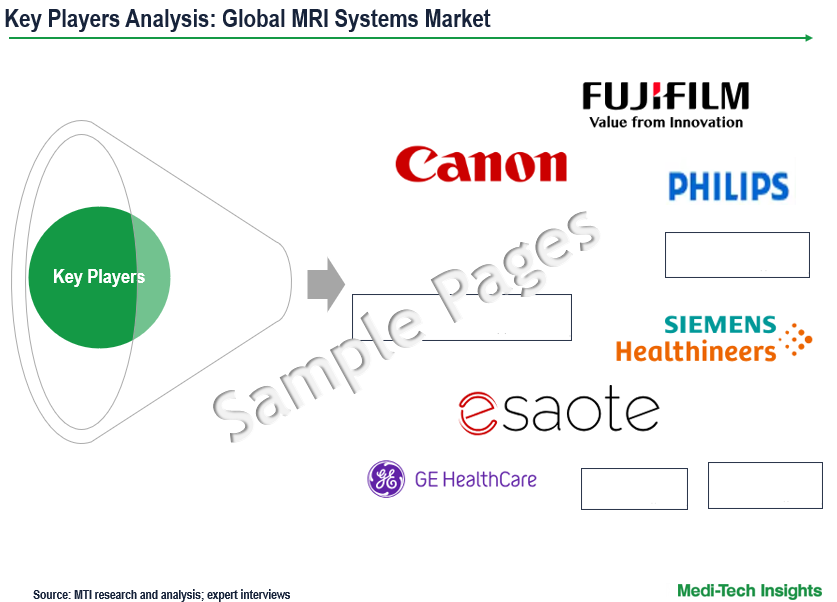
Global MRI Systems Market Size & Trends Report Segmented by Architecture (Closed MRI, Open MRI Systems), Field Strength (Low-to-Mid-Field, Ultra-High-Field), Application (Cardiac, Vascular, Abdominal), & Regional Forecasts to 2030
The MRI systems market is projected to grow at a CAGR of ~5% over the forecast period. Major factors driving the growth include the rising prevalence of chronic diseases, growing aging population, increased demand for non-invasive diagnostic imaging, technological advancement in MRI Systems, and growing adoption of advanced imaging techniques like functional MRI (fMRI) in research and clinical application. However, the market encounters challenges, including the high cost of MRI systems, stringent regulatory approvals and reimbursement limitations, and a lack of skilled professionals. To learn more about the research report, download a sample report.
Report Overview
Magnetic Resonance Imaging (MRI) systems are non-invasive imaging technologies that utilize strong magnetic fields and radiofrequency waves to generate highly detailed, cross-sectional images of organs, tissues, and structures within the human body. MRI systems are commonly employed for disease detection, diagnosis, and treatment monitoring. They offer a safer alternative to imaging modalities like X-rays or CT scans, as they do not involve ionizing radiation. This advanced technology operates by exciting and detecting changes in protons in the water that constitute living tissues.
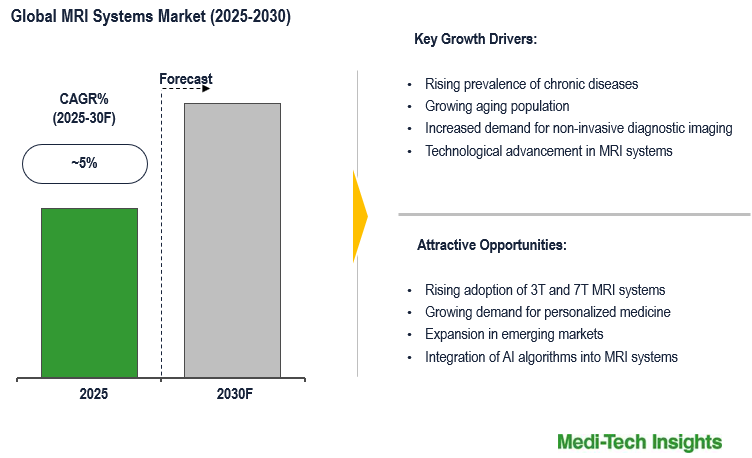
To learn more about this report, download the PDF brochure
Growing prevalence of chronic diseases drives market growth
Chronic diseases, including diabetes, heart disease, stroke, and cancer, remain the leading causes of morbidity and mortality worldwide. A study by the World Economic Forum (WEF) estimates that the global economic burden of chronic diseases could reach $47 trillion by 2030. MRI systems are particularly well-suited for diagnosing a broad spectrum of chronic conditions, as they provide high-resolution, detailed images of soft tissues, organs, and structures without using ionizing radiation. This capability makes MRI systems essential for managing chronic illnesses, saving millions of lives annually by delivering precise images and critical data that shed light on the underlying mechanisms of diseases. These insights have empowered researchers to develop more targeted and effective therapies, revolutionizing diagnostic and treatment approaches. Consequently, MRI systems have become an integral part of modern healthcare.
Advancements in MRI systems technologies fuel its demand
Technological advancements in MRI systems have transformed their functionality, efficiency, and accessibility, addressing critical challenges such as scan times, patient comfort, and diagnostic precision. These innovations not only improve clinical outcomes but also create new opportunities in personalized medicine, research, and remote healthcare. Key advancements driving the growing demand for MRI systems include:
- Compressed sensing and artificial intelligence (AI): Compressed sensing, often combined with AI, can reduce scan times by 50% or more, improving patient throughput and comfort.
- Helium-free MRI systems: Helium-free MRI systems have enabled the installation of smaller, lighter devices in locations where traditional, bulkier systems would not be practical.
- Enhanced Imaging Capabilities: The increasing adoption of high-field MRI systems, such as 3 Tesla (3T) and 7 Tesla (7T), delivers superior image resolution, particularly for detailed neurological and cardiovascular imaging. Advancements in fMRI technology allow for real-time mapping of brain activity, providing critical insights for neurological research and treatment planning.
- Portable MRI Devices: Compact, mobile MRI systems enable imaging at the bedside or in remote and underserved areas, significantly expanding access to high-quality diagnostic imaging.
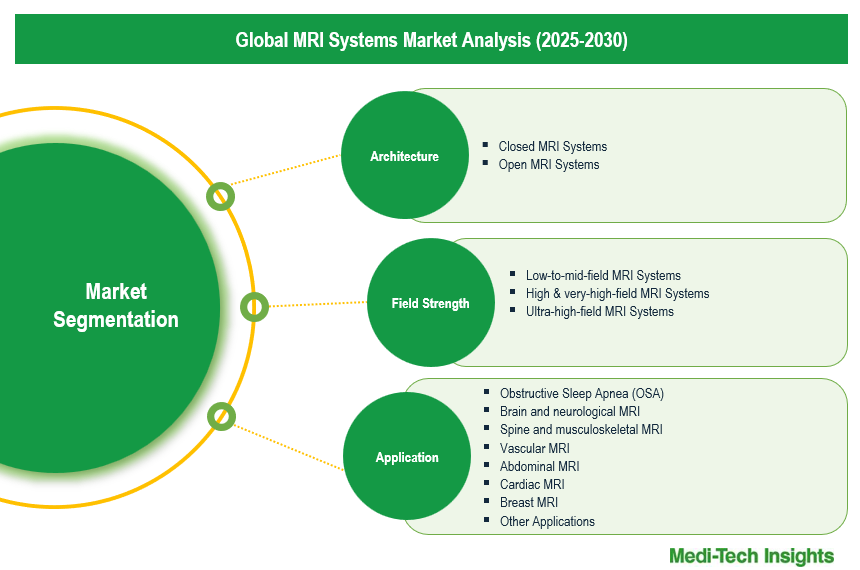
To learn more about this report, download the PDF brochure
Competitive Landscape Analysis
The global MRI systems market is marked by the presence of established and emerging market players such as GE Healthcare; Koninklijke Philips; Siemens Healthineers; Canon Medical Systems Corporation; Esaote SpA; Hitachi Medical Corporation; Hologic Inc.; Bruker Corp.; Fujifilm Holdings Corp.; Shimadzu Corp.; Aurora Imaging Technologies, Inc.; United Imaging Healthcare; Time Medical Systems; and Hyperfine among others. Some of the key strategies adopted by market players include new product development, strategic partnerships and collaborations, and investments.
Report Scope
| Report Metric | Details |
| Base Year Considered | 2024 |
| Historical Data | 2023 - 2024 |
| Forecast Period | 2025 - 2030 |
| Growth Rate | ~5% |
| Market Drivers |
|
| Attractive Opportunities |
|
| Segment Scope | Architecture, Field Strength, Application, and End User |
| Regional Scope |
|
| Key Companies Mapped | GE Healthcare; Koninklijke Philips; Siemens Healthineers; Canon Medical Systems Corporation; Esaote SpA; Hitachi Medical Corporation; Hologic Inc.; Bruker Corp.; Fujifilm Holdings Corp.; Shimadzu Corp.; Aurora Imaging Technologies, Inc.; United Imaging Healthcare; Time Medical Systems; and Hyperfine |
| Report Highlights | Market Size & Forecast, Growth Drivers & Restraints, Trends, Competitive Analysis |
Global MRI Systems Market Segmentation
This report by Medi-Tech Insights provides the size of the global MRI systems market at the regional- and country-level from 2023 to 2030. The report further segments the market based on architecture, field strength, application, and end user.
-
Market Size & Forecast (2023-2030), By Architecture, USD Million
- Closed MRI Systems
- Open MRI Systems
-
Market Size & Forecast (2023-2030), By Field Strength, USD Million
- Low-to-mid-field MRI Systems
- High & very-high-field MRI Systems
- Ultra-high-field MRI Systems
-
Market Size & Forecast (2023-2030), By Application, USD Million
- Obstructive Sleep Apnea (OSA)
- Brain and neurological MRI
- Spine and musculoskeletal MRI
- Vascular MRI
- Abdominal MRI
- Cardiac MRI
- Breast MRI
- Other Applications
-
Market Size & Forecast (2023-2030), By End User, USD Million
- Hospitals
- Diagnostics Imaging Center
- Others
-
Market Size & Forecast (2023-2030), By Region, USD Million
- North America
- US
- Canada
- Europe
- UK
- Germany
- Italy
- Spain
- Rest of Europe
- Asia Pacific
- China
- India
- Japan
- Rest of Asia Pacific
- Latin America
- Middle East & Africa
- North America
Key Strategic Questions Addressed
- What is the market size & forecast of the MRI systems market?
- What are the historical, present, and forecasted market shares and growth rates of various segments and sub-segments of the MRI systems market?
- What are the key trends defining the market?
- What are the major factors impacting the market?
- What are the opportunities prevailing in the market?
- Which region has the highest share in the global market? Which region is expected to witness the highest growth rate in the next 5 years?
- Who are the major players operating in the market?
- What are the key strategies adopted by players?
The study has been compiled based on extensive primary and secondary research.
Secondary Research (Indicative List)
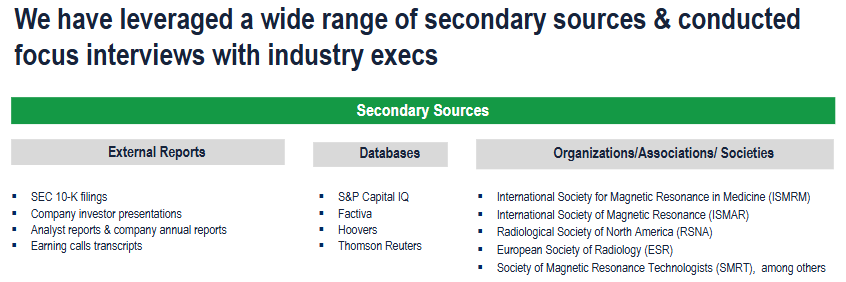
Primary Research
To validate research findings (market size & forecasts, market segmentation, market dynamics, competitive landscape, key industry trends, etc.), extensive primary interviews were conducted with both supply and demand-side stakeholders.
Supply Side Stakeholders:
- Senior Management Level: CEOs, Presidents, Vice-Presidents, Directors, Chief Technology Officers, Chief Commercial Officers
- Mid-Management Level: Product Managers, Sales Managers, Brand Managers, R&D Managers, Business Development Managers, Consultants
Demand Side Stakeholders:
- Stakeholders from Hospitals, Diagnostics Imaging Centers, and Others
Breakdown of Primary Interviews
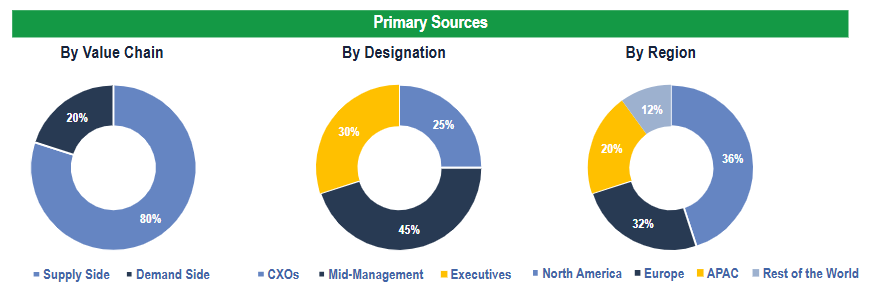
Market Size Estimation
Both ‘Top-Down & Bottom-Up Approaches’ were used to derive market size estimates and forecasts.
Data Triangulation
Research findings derived through secondary sources & internal analysis were validated with Primary Interviews, the Internal Knowledge Repository, and the Company’s Sales Data.

